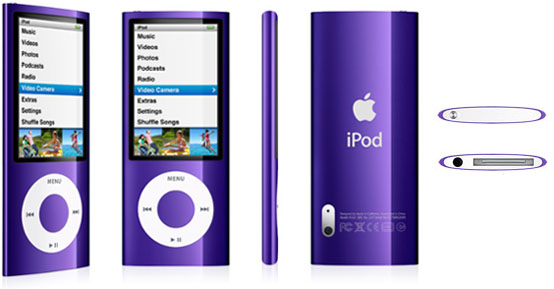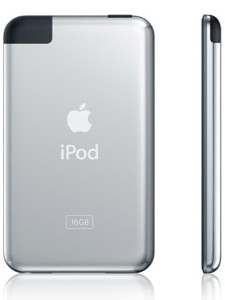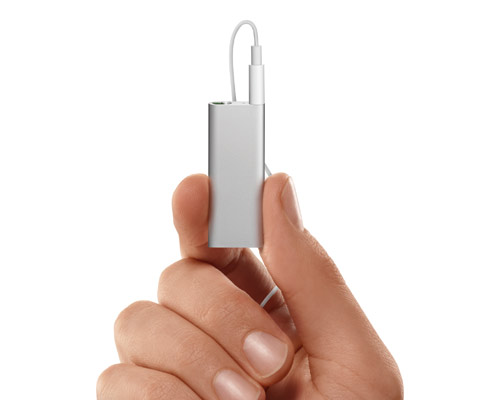Released on January 11, 2005, the first-generation iPod Shuffle weighed 0.78 ounces (22 g) and was designed to be easily loaded with a selection of songs and to play them in random order. According to Apple,[citation needed] owners of existing iPods had often left the music selection to "shuffle", and the new iPod Shuffle was a way of implementing that in a much more cost-effective fashion. It relies on the use of an "autofill" feature in iTunes, which can select songs at random from a user's music library (or from a specific playlist) and copy as many as will fit into the iPod Shuffle's memory. The Shuffle can hold up to 240 songs (1-GB model, based on Apple's estimate, of four minutes per song and 128 kbit/s AAC encoding). It used the SigmaTel STMP35xx system on a chip (SOC) and its software development kit (SDK) v2.6, a flash memory IC, and USB rechargeable lithium cell. The STMP35xx SOC and its software was the most fully integrated portable MP3 playback system at release time and SigmaTel was Austin's largest IPO (2003) capturing over 60 % of flash based MP3 player world market share in 2004. In 2005, peak iPod first-generation Shuffle production occurred at a hundred thousand units per day, at the Asus factory.
Due to superior audio technology in the SigmaTel STMP35xx SOC and SDK, the iPod Shuffle has a better bass response than a 4th generation iPod, according to a review published days after its release.
iTunes offers some new features for iPod Shuffle. One is the ability to reduce the bit rate of songs to 128 kbit/s AAC. The conversion is done automatically, with the original file left untouched on the computer and the smaller (lower bit rate) file sent to the iPod Shuffle. Older versions of iTunes allowed an iPod Shuffle playlist to be viewed and changed while the unit is not connected; the next time the unit is connected, it can then be updated with the changed playlist. This functionality is no longer a part of iTunes as of iTunes 7.
The front of the iPod Shuffle has buttons for Play/Pause, Next Song/Fast Forward, Previous Song/Fast Reverse, and up and down volume adjustment. On the reverse, it has a battery level indicator light (activated by a button) and a three-position switch to turn the unit off or set it to play music in order or shuffled. It plugs directly into a computer's USB port (either 1.1 or 2.0), through which it also recharges its battery, which has an expected life of around 12 hours between charges. The USB plug is hidden beneath a cap. The unit also comes with a lanyard that attaches to the iPod Shuffle via an attached cap and this allows the user to wear the iPod Shuffle around his or her neck.
The iPod Shuffle can also be used as a USB flash drive. iTunes allows a user to set how much of the drive will be allowed for storing files, and how much will be used for storing music.
On September 12, 2006, Apple announced the release of the second generation iPod Shuffle, calling it "the most wearable iPod ever". First shipments of the unit were slated for an October 2006 arrival, but actually started shipping on Friday, November 3, 2006. The second generation initially featured a lone 1 GB model in a silver brushed aluminum case similar to the second generation iPod Nano and the older iPod Mini. The new model is less than half the size of the first generation model at 41.2 x 27.3 x 10.5 mm (1.62 x 1.07 x 0.41 in), and is the size of the iPod Radio Remote available for iPod Nanos and 5th generation iPods. Apple claimed it was the "world's smallest MP3 player". This size includes the new built-in belt clip; the actual unit itself is thinner, with the entire device weighing only 15.5 g (0.55 ounces). The power/shuffle/no shuffle switch from the first generation version was separated into two controls to avoid an accidentally selected mode of operation. The formatting of the iPod itself is new to Apple, as the 2G (2nd Generation) shuffle will only format itself to FAT32. iTunes issues a warning that the iPod is incorrectly formatted if brought to the Macintosh format HFS+. All previous iPod models have allowed the usage of either the Mac format or the Windows format.
On the second generation iPod Shuffle, USB connectivity is provided via an included piece of hardware which acts as a docking station for the transfer of data and the recharging of the iPod's internal battery through its headphone jack. The second generation iPod Shuffle is also able to act as a flash drive, just like the first generation iPod Shuffle. However, unlike the first generation iPod Shuffle, the second generation does not have a built-in USB connector. This means that the docking station is required for connection to a computer on the second generation model. The second generation Shuffle can play MP3, MP3 VBR, AAC, Protected AAC, Audible (formats 2, 3 and 4), WAV and AIFF. Due to its low processing power the only iTunes-supported file format that the iPod does not support is Apple Lossless.[citation needed] Using large file sizes inherent of WAV or AIFF files will very quickly fill the device's low 1 GB capacity. iPod Shuffle cannot play music from music video files. On January 30, 2007, Apple announced the addition of four new colors to the iPod Shuffle line. Pink, orange, green, and blue choices have been made available via retailers and the Apple Store (online) in addition to the original silver color. The colors blue, green, and pink are essentially the same hues as the second generation iPod Nano and iPod Mini. The new orange color is a first for the iPod franchise. They also now come with the new redesigned headphones that were not included with the original silver model. The box was also changed to have gray text instead of the lime-green text; lime-green text indicating that the original headphones are included, gray text indicating that the new headphones are included On September 5, 2007, Apple refreshed the line with four new colors including a Product Red version. The new colors are turquoise, lavender, mint green, and Product Red, with the previous colors orange, blue, green, and pink being discontinued.
Due to superior audio technology in the SigmaTel STMP35xx SOC and SDK, the iPod Shuffle has a better bass response than a 4th generation iPod, according to a review published days after its release.
iTunes offers some new features for iPod Shuffle. One is the ability to reduce the bit rate of songs to 128 kbit/s AAC. The conversion is done automatically, with the original file left untouched on the computer and the smaller (lower bit rate) file sent to the iPod Shuffle. Older versions of iTunes allowed an iPod Shuffle playlist to be viewed and changed while the unit is not connected; the next time the unit is connected, it can then be updated with the changed playlist. This functionality is no longer a part of iTunes as of iTunes 7.
 The iPod shuffle 3G is the |  iPod shuffle front, back and | iPod shuffle 3rd Generation | Apple iPod Shuffle Review |  iPod shuffle 3rd Generation |
 3rd generation: 1.8 x 0.7 x |  3rd Generation iPod Shuffle |  The iPod nano (5th generation) |  iPod Shuffle 3rd Gen. |  iPod touch features a 3.5-inch |
On September 12, 2006, Apple announced the release of the second generation iPod Shuffle, calling it "the most wearable iPod ever". First shipments of the unit were slated for an October 2006 arrival, but actually started shipping on Friday, November 3, 2006. The second generation initially featured a lone 1 GB model in a silver brushed aluminum case similar to the second generation iPod Nano and the older iPod Mini. The new model is less than half the size of the first generation model at 41.2 x 27.3 x 10.5 mm (1.62 x 1.07 x 0.41 in), and is the size of the iPod Radio Remote available for iPod Nanos and 5th generation iPods. Apple claimed it was the "world's smallest MP3 player". This size includes the new built-in belt clip; the actual unit itself is thinner, with the entire device weighing only 15.5 g (0.55 ounces). The power/shuffle/no shuffle switch from the first generation version was separated into two controls to avoid an accidentally selected mode of operation. The formatting of the iPod itself is new to Apple, as the 2G (2nd Generation) shuffle will only format itself to FAT32. iTunes issues a warning that the iPod is incorrectly formatted if brought to the Macintosh format HFS+. All previous iPod models have allowed the usage of either the Mac format or the Windows format.
 The 4GB iPod shuffle, |  The iPod shuffle 3G is the |  iPod Shuffle (3rd Generation) |  Apple iPod Shuffle (third |  Review: iPod shuffle (4GB, |
 Ipod Shuffle 3rd Generation |  iPod Shuffle 3rd Generation |  theory of moon landing |  Why the Moon Landing |  a \x26#39;Moon Landing\x26#39; souvenir |
No comments:
Post a Comment